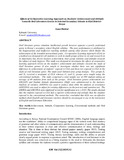Effects of Co-Operative Learning Approach on Students’ Achievement and Attitude towards Oral Literature Genres in Selected Secondary Schools in Kisii District
Abstract
ABSTRACT
Oral literature genres stimulate intellectual growth however appears a poorly performed
genre in Kenya’s secondary school English syllabus. The poor performance is attributed to
the inappropriate and ineffective teaching methods among other factors which hinder the
achievement of the intended instructional goals. Co-operative Learning Approach (CLA) as
a method was designed for all students to work in small groups of four to six and research on
its importance has shown learners achievement, inter-group relations and attitudes towards
the subject of study improve. This study was designed to investigate the effects of cooperative
learning approach (CLA) on the student’s achievement and attitudes towards the study of
Oral literature genres. It also sought to investigate whether there was any significant
difference in achievement of students’ exposed to CLA and those not exposed to CLA in the
study of oral literature genre. The study used Solomon four group designs. Two groups E1
and E2 received a treatment of CLA whereas C1 and C2 groups were taught using the
conventional methods. The study comprised a total sample size of 160 students taking an
average of 40 students from each of the groups. Oral literature genres achievement test
(OLGAT) and Student Attitude Questionnaire (SAQ) were administered to the learners.
Analysis of variance (ANOVA) was used to analyze data while the analysis of covariance
(ANCOVA) was used to adjust for existing differences on the post test and retention test. The
ANOVA and ANCOVA were employed to test for significance at α = 0.05. The results showed
that the students exposed to CLA had a superior achievement and attitude than the students
exposed to the conventional methods. The researcher concluded that CLA was an effective
method which English and literature teachers should be encouraged to use in the instruction
of English and Literature Education

